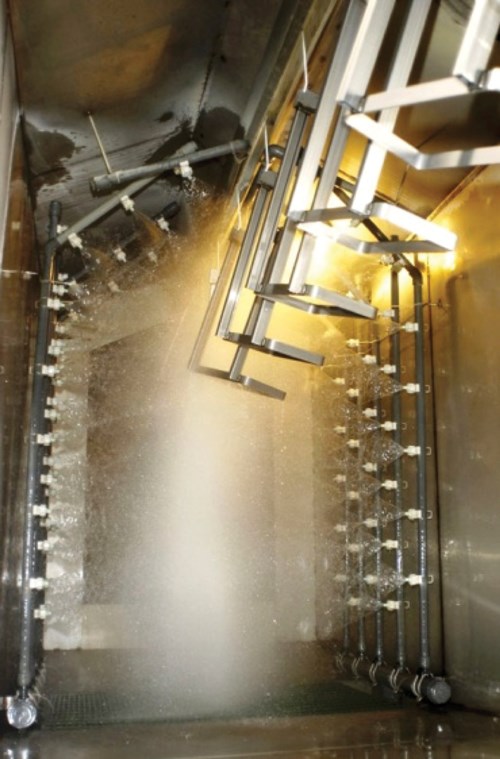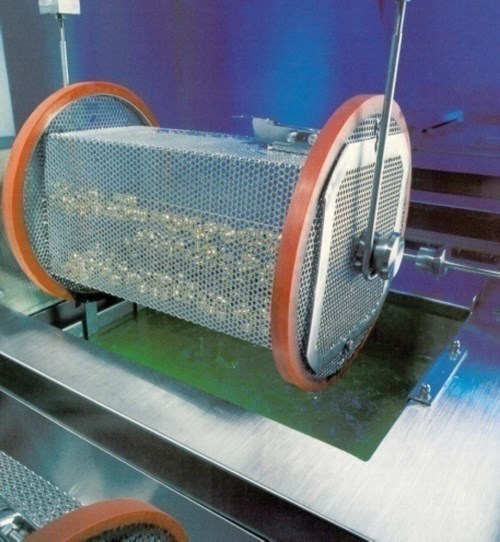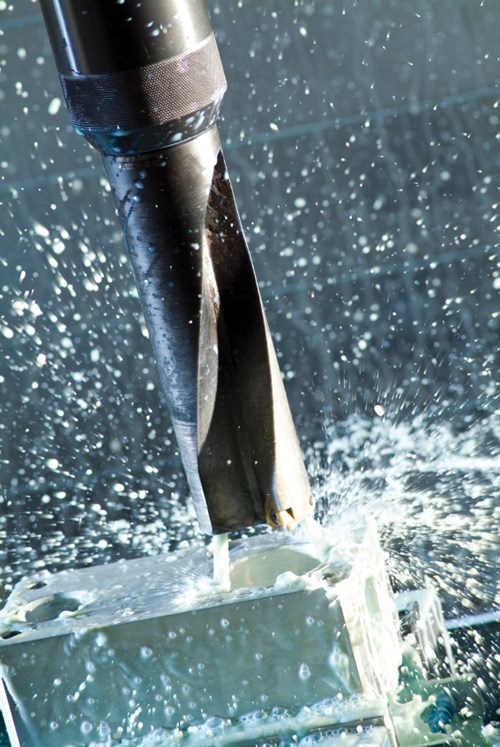Aligning Parts Cleaning with the Metalworking Process
Underperforming cleaning programs can result in defects, poor finishing quality.
Effectively cleaning machined or formed parts is a key step in all manufacturing processes—especially in surface finishing—but too often it is overlooked.
Underperformance of cleaning programs results in defects and poor quality of subsequent operations, yet over-cleaning is costly and wasteful. An effectively monitored and proactively managed parts cleaning process that delivers reliable performance is designed by addressing the substrates, machining operations and the fluids in the front end of the operation.
Based on the severity of the operations, the chemistry of machining fluids (coolants) and drawing and stamping fluids can vary greatly. Light-duty applications such as milling and drilling on cast iron or stamping lighter gauge stock can be performed with lower lubricity fluids. However, more severe operations, such as broaching, threading or gun drilling, with more challenging substrates such as stainless steels, hardened steels, Inconel or titanium, require high lubricity machining fluids. To obtain higher lubricity, formulators include higher levels of oil and often use extreme pressure additives to meet the performance requirements. Even straight oil cutting fluids include additives that affect the cleaning of the resulting parts.

The four key parameters of any aqueous cleaning program are captured in the term TACT: time, action, concentration and temperature.
Extreme Pressure (EP) additives will significantly boost the lubricity characteristics of coolants and drawing and stamping fluids. EP additives, at higher temperatures and pressures, plate out on the substrate surface in the cutting or forming process, greatly reducing the coefficient of friction, while depositing residues on the parts. Typically, EP additives are based on phosphorous, sulfur and/or chlorine, and in some cases, in the form of chlorinated paraffin. These compounds, by nature, are more difficult to remove in typical parts washing programs, and need to be addressed in the cleaning process
Certain operations create soils that are challenging to remove. Typical grinding fluids contain lower oil content with limited additives or are fully synthetic. This type of compound can be easily cleaned after light milling or drilling. However, in the grinding process, especially when the parts are cast iron or sintered metals, the resulting “swarf” can pose cleaning challenges. The graphite components and extremely small chips are very difficult to remove in typical parts washers, so enhanced cleaning is required.
With any machining program, a key to success in the cleaning process is coolant management. Always ensure the coolant concentration is in check, and continuously remove chips from the process. Tramp oils (typically hydraulic fluids and way lubes) must be continuously removed by skimming, coalescing or with a centrifuge. Good housekeeping in the front-end will assure more consistent and efficient cleaning downstream.
Aged coolant or stamping fluids left on machined parts for an extended time are more difficult to remove, and the potential for corrosion is high. Parts should transfer as quickly as possible from the machining centers to the washers. When parts are machined or formed off site, a cleaning process prior to shipment (along with the application of rust preventive) is appropriate.
In selecting a parts cleaning program, one has many options, including the use of solvent. Ideally, most machined or stamped parts use aqueous cleaning.

Immersion washers using racks, baskets or barrels are also effective.
Washer Types
Recirculating spray washers are the most common washers in high-production environments. Belt or conveyor washers, in single or multiple stages, enable a maximum number of parts to be processed. Spray nozzles should be aligned for the optimum patterns to ensure that the cleaning compound reaches critical areas. Higher pressures will provide improve soil removal (more “action” by the chemistry), and cabinet washers are also effective, especially if the part is rotated to enable effective contact of the chemistry.
Immersion washers using racks, baskets or barrels are also effective for improved cleaning with added mechanical action, which can be achieved with circulation pumps or eductors in the tanks. The part-to-part contact of a barrel or tumbling program is also beneficial, as long as parts are not damaged in the cleaning process.
Ultrasonic energy will substantially improve the cleaning process. Ultrasonic washers dislodge surface contaminants using high-frequency sound waves to agitate the cleaning solution, creating bubbles that rapidly implode on the part’s surface. Ultrasonic cleaning is especially effective on challenging inert soils such as graphite, and enables better cleaning in deeply recessed areas such as blind holes and lap seams.
Manufacturers have several choices when selecting an aqueous cleaning chemistry for parts washers. Alkaline cleaners are often chosen for their effectiveness on most soils, especially organic, and are compatible with ferrous substrates, and most washers. Suppliers are able to formulate alkaline cleaners that can be used on aluminum, zinc (and zinc-coated substrates) and yellow metals (copper and brass).
Acid cleaners can be effective when inorganic soils like oxides, scale or corrosion need to be removed from the surface of parts. Proper selection of equipment is required with acidic chemistry. Neutral cleaners typically rely on higher levels of surfactants or water soluble solvents to provide sufficient detergency. These formulations offer the benefit of greater worker acceptance and environmental favorability, but can be prone to biological degradation.
The four key parameters of any aqueous cleaning program are captured in the term TACT: time, action, concentration and temperature. These are the four essential factors that must be controlled to ensure success. If any one of these parameters is compromised, for example when the time of the parts in the washer is reduced to increase throughput, one or all of the other three factors must be reviewed and adjusted to maintain a consistent cleanliness level.
Of the four TACT components, shops should focus most deeply on the “action” of their washer programs. Mechanical action will greatly aid the cleaning process, meaning effective spray impingement in spray washers (including nozzle design and alignment), agitation in immersion programs, and effective ultrasonic action. Regardless of the type of washer, the mechanical action should always be optimized. This is essential when more challenging soils are present. Cleanliness is required in an aqueous program. While visual inspection is helpful, a test that generates a recordable data point is reassuring from a quality perspective. Make sure cleanliness tests are performed in a reproducible manner, ideally by the same technician, for valid results. Carbon analyzers, contact angle and residue tests, such as Millipore testing, can be effective. Simple practices like checking for a water-break-free surface (using clean water), tape-pull testing or white glove testing can also provide valuable data. Cleanliness testing is always relative; bench mark levels need to be established that can be associated with acceptable performance, and the operation should be kept within upper and lower limits at all times.
Aqueous washers, like all chemical processes, need to be monitored and maintained. Typically, a titration is performed to determine the concentration of the chemistry, and should be done once per shift. Documenting parameters like concentration, pH, conductivity, spray pressure and temperature is good standard operating practice, and a suitable data logging system must be implemented.
An aqueous cleaner removes the soils, and in an ideal system, those soils are continuously removed from the washer. Filtration can remove insoluble material from the tanks, such as metal chips or swarf. With ferrous programs, magnetic separators can be combined with bag filters. Oils can be removed from the washer using skimmers or coalescers, and a cleaning compound designed to reject oils can aid the soil removal process. The catch is to be certain that cleaned parts are not removed through a blanket of oil to prevent redeposition of soils back onto the parts.

An effectively monitored and proactively managed parts cleaning process that delivers reliable performance is designed by addressing the substrates.
Even with good housekeeping and maintenance, all chemical programs will eventually reach the point when they need to be recharged. Knowing when recharging is required contributes to success. With cleaners, utilizing free to total alkalinity titration can help process efficiency. Many alkaline cleaners are controlled by free alkalinity titrations, so this value will remain constant as you replenish the solution with fresh product. But over time, the total alkalinity will rise in value (typically using indicators with a color change at a pH close to 4, such as methyl orange), as soils build in the solution. You can record this ratio value, and make plans to recharge before it hits an upper limit associated with poor cleaning.
The health of a cleaner bath can also be measured by the amount of emulsified oils in the solution. This soil load can be performed by collecting a specific volume in a stoppered graduated cylinder, and carefully adding phosphoric or sulfuric acid (for alkaline cleaners) and/or excess table salts. The soils will float to the surface of the cylinder, and the volume can be measured. The surfactants in the cleaner may also come out of the solution, so you want to perform this test when the bath is fresh, and compare to future values as they increase.
While many programs use single-stage washers, adding a rinse stage will improve cleaning and reduce residues. The rinse stage will flush away the soil-detergent complexes and complete the cleaning process. Rinses, monitored by conductivity, should be neutral and overflowed to remain clean.
With any aqueous program, corrosion of cleaned parts is a concern. Corrosion can occur within the washer program or after the cleaning stage is complete, or while parts are in storage. To mitigate corrosion, cleaners can be formulated to include rust preventive agents, which can be used in single-stage washers, or applied with an aqueous rust preventive after the rinse stage. Rinsing will eliminate the rust preventive’s performance, so allow the rust preventive to dry on the surface of the parts.
Drying of parts will lessen the potential of surface corrosion. Air blow off, drying media or ovens can aid the drying process, as does heating the final stage of the washer.
Potential for corrosion in aqueous washers increases when “afflictive ions” cycle up in the final stage. These are most typically chlorides and sulfates, which are present in most tap water at various levels. As water evaporates from the cleaning stage, these afflictive ions increase in concentrations. Monitoring the level of chloride and sulfate over time and establishing upper limits for your process will help assure corrosion-free production. Use of RO or DI water may be required if levels are significantly high in your tap water. The potential for corrosion is directly related to humidity levels, so the summer months are the most challenging periods. Adjusting the level of rust preventive to compensate for humidity levels is a very good idea.
Cleaning and rinsing are the most important steps in any aqueous cleaning or pretreatment program. Having a full understanding of the machining program and the specific challenges that it poses to the cleaning of parts, a shop can design and operate a parts washing process that ideally fits its requirements. Controlling the chemistry and the filtration process, both in the machining and washing steps, are essential for success. This includes proactive maintenance (filtration, soil removal and cleanliness testing) and effective troubleshooting. With proper design and operation, you can be assured of consistent premium quality production at a controlled cost—the foundation for a sustainable and competitive manufacturing program.
Originally published in the November 2015 issue.
Related Content
Alkaline Cleaning Guide
Gregg Sanko, Senior Chemist, Oakite Products, Inc. provides an overview of the alkaline cleaning process.
Read MoreClean Technology Lasers for Coating Adhesion
Laser cleaning systems remove corrosion, grease, residue and existing coatings from metal surfaces quickly, with less preparation and mess than traditional techniques.
Read MorePretreatment of Black Oxide
Having issues achieving a consistent color with the application of black oxide? Start by looking at your pretreatment. Connor Callais of Hubbard-Hall offers advice for troubleshooting your black oxide process.
Read MoreRead Next
Episode 45: An Interview with Chandler Mancuso, MacDermid Envio Solutions
Chandler Mancuso, technical director with MacDermid Envio discusses updating your wastewater treatment system and implementing materials recycling solutions to increase efficiencies, control costs and reduce environmental impact.
Read MoreA ‘Clean’ Agenda Offers Unique Presentations in Chicago
The 2024 Parts Cleaning Conference, co-located with the International Manufacturing Technology Show, includes presentations by several speakers who are new to the conference and topics that have not been covered in past editions of this event.
Read MoreEducation Bringing Cleaning to Machining
Debuting new speakers and cleaning technology content during this half-day workshop co-located with IMTS 2024.
Read More





















